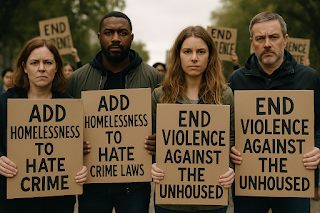Invisible Targets: The Violence, Stigma, and Struggle of America’s Homeless
Some stories keep me awake at night.
The story of Aaron Taylor is one of them.
It was Christmas Day, 2007, in Phoenix, Arizona. Aaron a man who struggled with homelessness and addiction was sleeping on a bench outside a Subway restaurant. That night, he was set on fire by people who saw him as nothing more than garbage. He suffered burns over half his body and died in agony at the hospital. His killers have never been brought to justice.
He was 36 years old.
Stories like Aaron’s are not isolated. Across cities, suburbs, and small towns, people experiencing homelessness endure acts of violence so brutal they barely sound real: beaten while they sleep, urinated on for sport, stabbed, shot, or set ablaze simply because they exist in public view.
These are not random attacks. They’re hate crimes, fueled by a belief that the homeless are less than human.
The Daily Gauntlet of Violence
Ask anyone who has lived on the streets: the threat of violence hovers like storm clouds, day and night. A man dozes off on a park bench, only to wake up to fists smashing his face. A woman tries to find a safe spot to sleep and is dragged into an alley. A young man rummages through trash for cans and has rocks hurled at his head from a moving car.
This isn’t just physical harm. It’s psychological warfare a relentless message that says:
“You don’t belong here. You are nothing.”
People experiencing homelessness are targets because they’re visible, vulnerable, and often voiceless. Many have nowhere to retreat behind locked doors. If attacked, some can’t call the police for fear of arrest for trespassing or vagrancy. Even when they do report violence, they’re too often dismissed as unreliable, intoxicated, or “crazy.”
The Weight of Addiction
It’s easy for those with roofs over their heads to say, “Why don’t they just get clean? Get a job? Get it together?”
But addiction is rarely the simple choice many believe it to be. On the streets, drugs and alcohol often become shields—a way to dull gnawing hunger, brutal weather, trauma, mental illness, and the constant threat of violence. Addiction can start as self-medication and end as a relentless captor, chaining a person to the same streets that broke them.
People experiencing homelessness want to survive, not just exist. But every day feels like an uphill climb with stones strapped to their ankles.
Imagine trying to recover from addiction while you have no place to sleep, no privacy, and constant harassment. Imagine struggling through withdrawal in a tent or on a park bench while people spit on you or call you “a worthless junkie.”
The Dehumanizing Gaze
This is perhaps the cruelest piece of it all: how society looks at homeless people if it looks at them at all.
We walk past them on sidewalks, eyes straight ahead, pretending we don’t hear their quiet requests for change. We joke about “bums” or “vagrants” and roll our windows up at intersections. Some people see a tent city and say, “Those people are ruining the neighborhood,” forgetting that those people are the neighborhood, too.
Worse, there are those who hate the homeless simply for existing. They see them as dirty, dangerous, morally weak, or criminal. They believe they don’t deserve safety, dignity, or life. That hatred fuels attacks like the one that killed Aaron Taylor.
Why Hate Crime Protections Matter
Here’s the truth: violence against homeless people is a hate crime. It’s violence motivated by hatred toward a group defined by their housing status. And yet, in the eyes of federal law, homelessness is not a protected class.
That has to change.
The federal Matthew Shepard and James Byrd, Jr. Hate Crimes Prevention Act protects people targeted for their race, religion, disability, sexual orientation, gender identity, and other characteristics. It sends a message that our society does not tolerate violence rooted in hate.
But where is that protection for the homeless? Where is the acknowledgment that setting a man on fire because he sleeps outside is just as monstrous as violence motivated by racism or homophobia?
Every Human Life Has Value
Aaron Taylor wasn’t just “some homeless guy.” He was a human being a son, a friend, a man who picked up litter in his neighborhood and shared food with others even when he barely had enough for himself.
His death is not merely a statistic. It’s a searing indictment of how cruelty thrives when society looks the other way.
We must demand change. We must push for laws that classify violence against the homeless as hate crimes. Not just to punish perpetrators, but to say, loudly and without apology:
Homeless lives matter. Their safety matters. Their humanity matters.
Until we do, people like Aaron Taylor will remain invisible targets silent victims of a violence that, heartbreakingly, too few people even bother to see.
How You Can Help
- Educate yourself and others. Share stories like Aaron’s. Challenge stereotypes.
- Support local shelters and harm reduction programs. Donate time, money, or resources.
- Push lawmakers. Write, call, and demand that homelessness be included in hate crime statutes.
- See people. Smile. Acknowledge their humanity. Offer kindness and dignity.
Because no one should be burned alive on Christmas Day or any day simply for having nowhere else to sleep.


Comments
Post a Comment